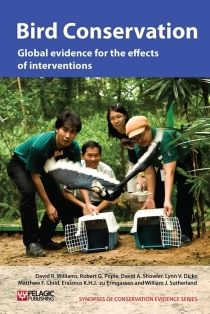Scientific evidence for the effects of conservation interventions is spread across numerous journals published around the world. Therefore, getting enough information to guide conservation actions may be time-consuming, and even unlikely for many conservationists who have no access to many journals.
Fortunately, a few initiatives are facilitating better access to information:
The Conservation Evidence Project
Based at the Department of Zoology, University of Cambridge, Conservation Evidence compiles, summarises and makes information on the effectiveness of interventions freely available to everyone, through a searchable and ever-growing database, at ConservationEvidence.com.
Conservation synopses
Conservation Evidence also publishes books in the form of synopses dedicated to single taxonomic groups or conservation issues. These synopses aim to compile all the information available on the effectiveness of all possible interventions to conserve each group. Synopses already available include: Farmland Conservation, Bee Conservation and Bird Conservation. Other synopses are currently being developed, such as Bat Conservation, Amphibian Conservation and Carnivore Conservation.
Bird Conservation: global evidence for the effects of interventions: The Bird Conservation Synopsis is a valuable new resource that compiles the evidence for 322 different interventions that could benefit birds. It summarises more than 1200 studies on how effective those interventions are at conserving birds and what is known and not known about their effects.
The Bird Conservation Synopsis includes more than 30 conservation interventions directly related to seabirds based on 73 individual studies.
You can buy a hard copy, download a free PDF copy, or read and search online.
Read the reviews of this book at Thinking Naturally and at Mark Avery´s blog.
Conservation Evidence Journal
The journal Conservation Evidence publishes concise, peer-reviewed papers on the results of interventions for conserving biodiversity. Papers are freely accessible and written with goal of informing conservation actions. Here is a list of some papers directly related to seabird conservation.
BirdLife’s State of the World’s Birds
This resource is the result of a large collaborative enterprise involving the BirdLife Partnership and researchers around the world. It aims to make science-based information available to national and international policy and decision makers, and to promote better conservation practice.
The State of the World’s Birds presents information on the current and potential future status of the birds around the world. It contains 350 individual case studies that illustrate these general trends. The SOWB website comprises four sections:
Introduction: why birds and biodiversity are important
State: what we know about the changing status of birds
Pressure: why birds are declining
Responses: what can be done to improve the status of birds
Check out the new State of the World’s Birds 2013 report, just launched at the BirdLife Congress in Canada in June, summarizing the results of this enterprise. The complete set of information is available for free at the website.
BirdLife’s SOWB database includes 44 case studies directly related to seabird conservation
Collaboration for Environmental Evidence
CEE is a community of scientists who synthesize information in the form of systematic reviews on important and complex issues related to environmental policy, using a rigorous and transparent methodology. The project has also an open access journal, Environmental Evidence.
Leave a comment